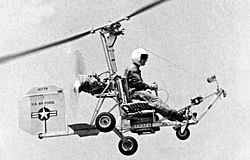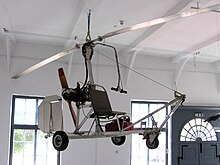Bensen X-25
| Bensen X-25 | |
|---|---|

|
|
| Type: | Gyroplane |
| Design country: | |
| Manufacturer: |
Bensen Aircraft Corporation |
| First flight: |
December 6, 1955 |
The Bensen X-25 is a gyroplane that was developed as a test aircraft as part of the United States Air Force Discretionary Descent Vehicle ( German about vehicle for descent at its own discretion ) program.
history
The aim of the project was to replace the ejection seats of fighter aircraft with the X-25 in order to give the pilots more control over the descent after the committee from the aircraft. The pilots should have more control over where exactly they land after the jump with the ejector seat.
The X-25B was a non-motorized vehicle and no manned tests were carried out on it. The X-25A, however, was motorized. Both aircraft were used to research the control and training requirements for the use of a gyroplane. However, experiments were never carried out in full. The first flight of the X-25A was on June 5, 1968. The DDV program was discontinued by the United States Air Force with the end of the Vietnam War .
The X-25A is in the National Museum of the United States Air Force in Dayton ( Ohio issued) and the X-25B in AFFTC Museum (Air Force Flight Test Center).
Bensen B-8M
The test aircraft X-25B and X-25A examined for the program was a Bensen B-8 gyroplane. The Bensen B-8 is a small, single-seat gyroplane that was developed by Igor Bensen (Bensen Aircraft) in the USA in the 1950s. Although the original manufacturer stopped production in 1987, plans for self-construction were made available until 2007.
The design of the Bensen B-8 was the result of an improvement on the Bensen B-7, a non-motorized tow gyroplane (motorless miniature gyroplane). The Bensen B-8, like its predecessor, the Bensen B-7, was initially built as a motorless towed gyroplane. It flew in this form for the first time in December 1955. On July 8, 1957, the modified version of the Bensen B-8M (M for motorized) had its maiden flight. The construction turned out to be very useful and was popular for many years. Thousands of plans of this type were sold over the next 30 years.
The construction of the Bensen B-8 is very minimalist; the aircraft does not consist of much more than the pilot's seat, a tail boom, the rotor and, in the motorized version, the engine.

Technical specifications
| Parameter | Data from the B-8M gyro-copter |
|---|---|
| Manufacturer | Bensen |
| Rotor diameter | 6.10 m |
| length | 3.45 m |
| height | 1.90 m |
| Max. Takeoff mass | 227 kg |
| Empty mass | 112 kg |
| crew | 1 |
| Top speed | 137 km / h |
| Service ceiling | 5030 m |
| Range | 160 km |
| Engines | a McCulloch Model 4318E four-cylinder boxer engine with 72 hp (53 kW) or a 90 hp (66 kW) engine with the same weight and dimensions |
Web links
Individual evidence
- ↑ Description on history.nasa.gov p. 33. (PDF; 1.2 MB) Retrieved on February 11, 2013 .